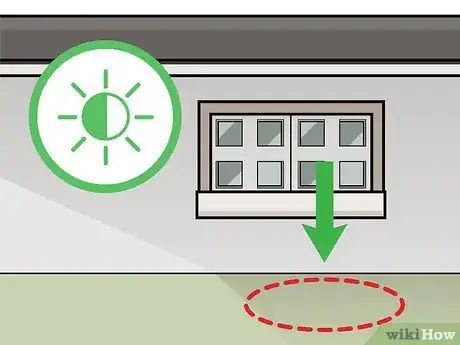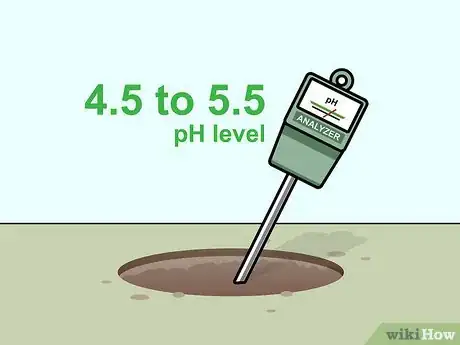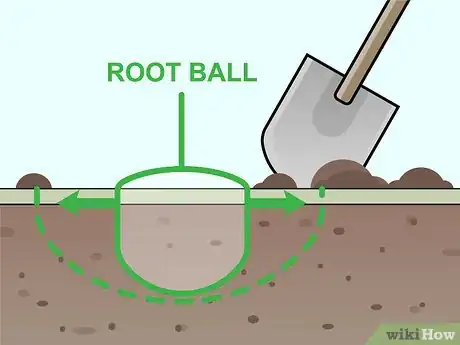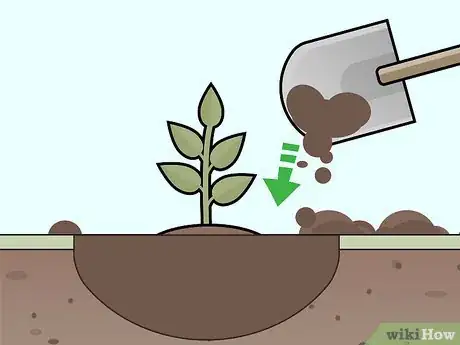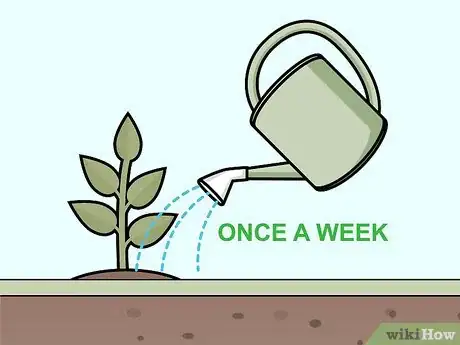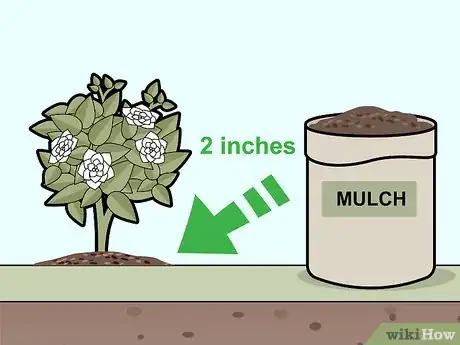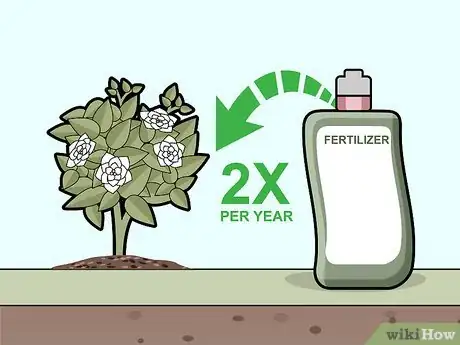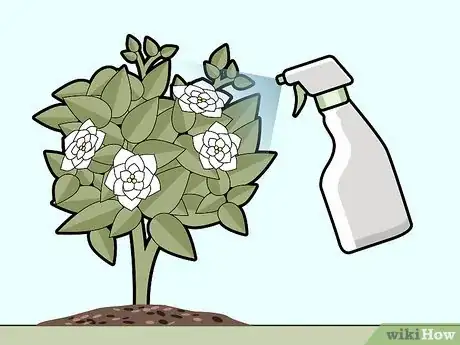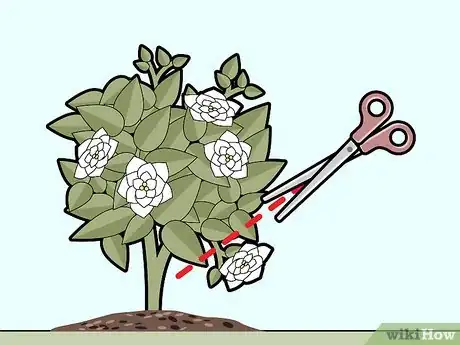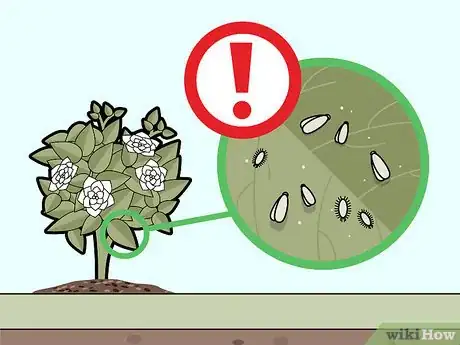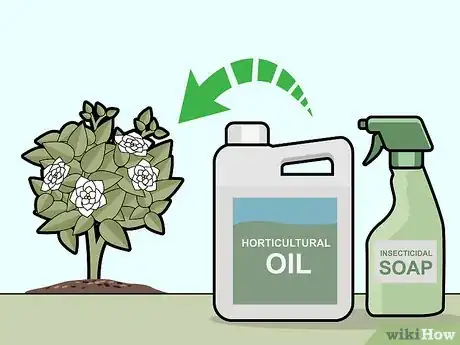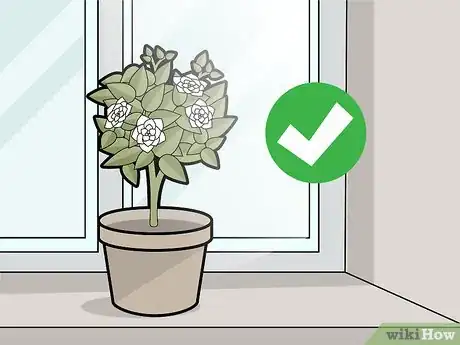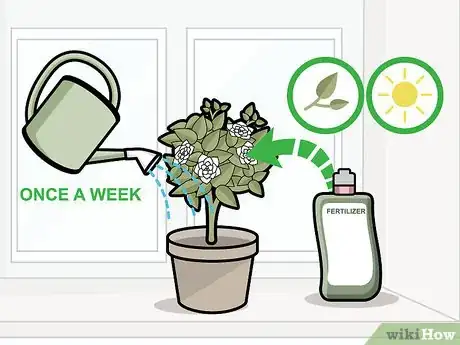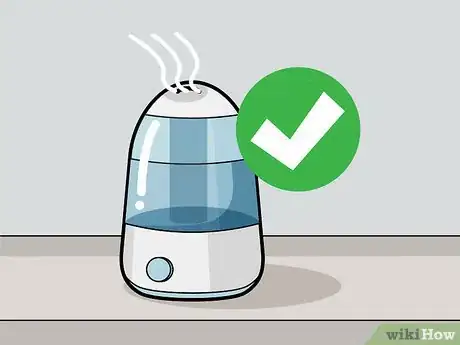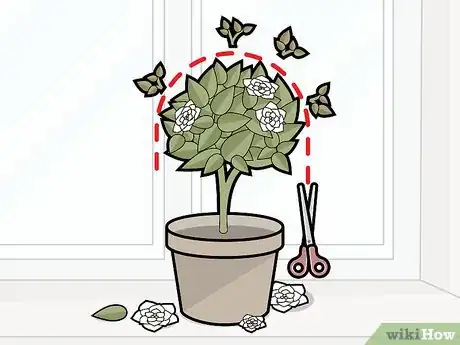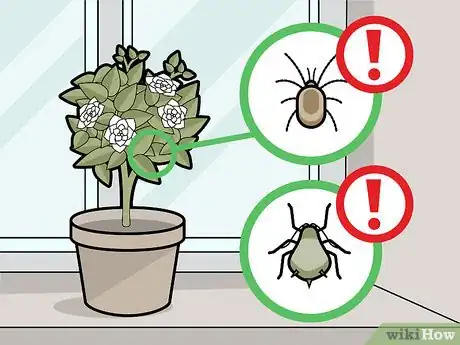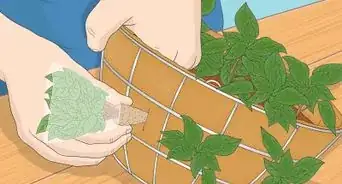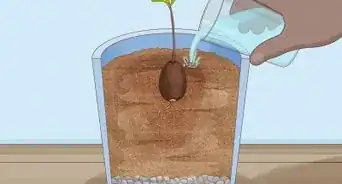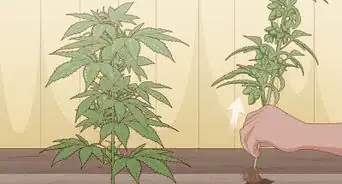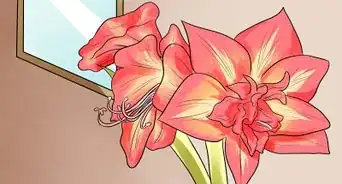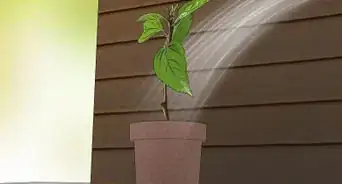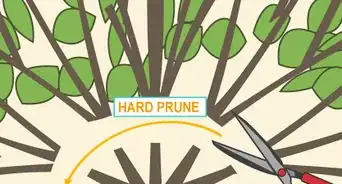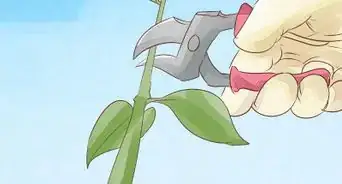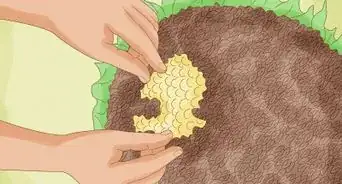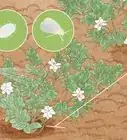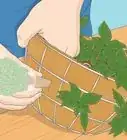This article was co-authored by Maggie Moran. Maggie Moran is a Professional Gardener in Pennsylvania.
There are 12 references cited in this article, which can be found at the bottom of the page.
wikiHow marks an article as reader-approved once it receives enough positive feedback. This article received 25 testimonials and 92% of readers who voted found it helpful, earning it our reader-approved status.
This article has been viewed 510,323 times.
The gardenia, also called the cape jasmine, is one of the most fragrant flowers the home gardener can grow, but it presents a number of challenges. Gardenias need a specific soil acidity, plenty of water and light, cool temperatures and high humidity. They are also very vulnerable to pests. However, if you can overcome these challenges, you will be rewarded with beautiful, sweet-smelling blooms from spring through the summer.
Steps
Planting Gardenias Outdoors
-
1Find an area with full sun to light shade to plant your gardenias. Unlike most plants, gardenias are delicate and picky about their environment.[1]
- Gardenias thrive in partial shade, high humidity, and an even supply of moisture and nutrients.[2]
- Though they can be grown indoors, the hot, dry air and gloomy winter days can send the gardenia into a downward spiral.
- Ideal seasons to plant gardenias are during spring or fall, when there is the perfect amount of sun without too high a heat.[3]
- Flower buds will fail to form if day temperatures are higher than 70 °F (21 °C), if night temperatures exceed 65 °F (18 °C), or if they fall below 60 °F (16 °C) at night.[4]
- Keep in mind that gardenias cannot stand to winter outdoors. You must bring them inside for the winter.
-
2Test the pH levels of the soil to determine if the Gardenia will actually thrive when planted. pH is a measurement of how acidic the soil is, and too high an acidity will not sustain a gardenia root.
- Acidity is measured on a scale from 0-14, with 0 being the most acidic and 14 being the most basic. Gardenias prefer acidic soil, so a pH level of 4.5 to 5.5 would be optimal since it is only moderately acidic.[5]
- If necessary, add sulfur — a white powder that can be bought at most garden or home improvement stores — to help lower pH levels that are higher than 6.
- The soil itself should also be rich and well-drained. Gardenias require plenty of nutrients but their roots may die if over-watered.[6]
Advertisement -
3Dig a hole in the soil the size of the gardenia's root ball. Make sure the hole is 2-3 times wider, as you will pack it with dirt once the root ball is planted.
- A root ball is a mass formed by the roots of a plant and the soil surrounding them.
- If your soil is in poor condition, add a small amount of compost to the hole before laying the root ball down. Compost is organic fertilizer and will add nutrients that your soil may be deficient in.
- Carefully choose where to plant the shrubs. By planting close to your house, you can enjoy the scent of the blooms from a deck or through an open window. But too close may mean that the soil pH may become too high for the plants to thrive.
- Also keep in mind that gardenias need a lot of light, but can't tolerate heat. Perhaps opt to plant near a bedroom window rather than a kitchen window.
-
4Set the gardenia's root ball in the hole. Make sure the top of your gardenia’s root ball is above the surface. Fill the hole half full with soil and water it.
- Doing this will help to settle the soil and eliminate air pockets. You want your gardenia's roots to fit snugly into the soil so that it can absorb plenty of water and nutrients.
- If you intend on planting multiple gardenias, be sure that you leave 3–6 feet (0.9–1.8 m) between each root ball. The gardenia plant can grow anywhere from 2–8 feet (0.6–2.4 m) both tall and wide.[7] Planting too closely can result in overcrowding or competition between roots for water and nutrients.
-
5Fill the remainder of the hole with soil once the water has drained. Pack the soil gently around the root ball so that it is slightly loose. Water thoroughly.
Caring for Gardenias Outdoors
-
1Water gardenias with an inch of water once a week. Gardenias typically require an inch of rain in order to thrive, so adhere to that standard whenever watering.
- Monitor the soil frequently for moisture content, and water thoroughly as the top inch of the soil dries. Avoid over-watering the soil especially, because if it is kept too wet, the roots will be starved for air.[8]
-
2Apply a 2 inches (5.1 cm) layer of organic mulch to the gardenias. Mulch is made of decayed organic matter, such as leaves, bark, or compost and can be purchased at most gardening stores.
- Mulch not only enriches the soil, but it will also keep your soil moist, reduce the growth of weeds, and maintain constant soil temperature.
- For the best outcome, select a mulch made of wood chips, sawdust, or ground bark.
- Applying mulch is extremely important since gardenia roots are shallow, making them especially vulnerable to weeds.
-
3Feed the gardenias with acid fertilizer twice per year. Biannual fertilizing will promote healthy flower growth in your gardenia.
- Be sure that you feed with an acid fertilizer. The nutrients in this particular fertilizer are formulated for plants that prefer acidic soil. Applying regular fertilizer may not be sufficient for sustaining your gardenia.
- Beware of over-fertilizing, as this can lead to damaging salt accumulation.
-
4Mist your gardenias daily with a spray bottle. Now that you have taken steps to provide adequate sunlight, soil, and water, you will need to meet the gardenia's humidity requirements.
- Spraying with water raises the humidity around the plant, but only temporarily. Therefore, it must be done daily in order to ensure that the gardenia survives.[9]
- Other than spraying, you could plant gardenias in clusters without overcrowding them. This will create a pocket of humidity. To increase the humidity even further, you could place a dish of water in the middle of the cluster. As the water evaporates, it will cover the surrounding gardenias.
-
5Prune your gardenias in early spring to shape the bush. Deadhead after flowering to encourage more flowering.
- Pruning younger, dormant gardenias will cause more prolific blooming. The young plant is very resilient and will easily repair lost stems because it is not yet actively growing.[10]
- Remove scraggly branches and faded flowers. Gardenias are woody shrubs, so remove older, woody stems to encourage the growth of new branches.
- Prune the lowest branches which are in danger of touching the ground. This can lead to infections.
- Don't cut all the leaves off. Some leaves need to be left so the plant can still produce food for the root system.[11]
-
6Monitor your gardenias for whiteflies and mealybugs. These insects are especially attracted to gardenias and can impair growth or cause the plant to die.
- Mealybugs are grey, segmented pests. They feed on the sap of the gardenia and leave behind a waxy coating on the plant. This can result in twig death, impair plant growth, and cause leaves to drop prematurely.
- Whiteflies are tiny white insects that resemble small gnats. They produce honeydew and the black sooty mold which grows on it. This mold can cause gardenia leaves to turn yellow and drop prematurely.[12]
-
7Coat gardenias with insecticidal soap or horticulture oil in case of infestation. These solutions will kill both mealybugs and whiteflies and are available in most local gardening stores.
- If you are facing a large mealybug infestation, smother the gardenia with a good dose of insecticidal soap or horticulture oil. Two days after the first pass of insecticidal soap, cover the soil judiciously with a helpful fungus called Beauveria bassiana to kill any mealybugs that feed on roots. Beauveria bassiana is also available in most gardening/home improvement stores.
-
8Cover your gardenias with a blanket or cardboard box during winter cold snaps. Since gardenias are extremely sensitive to the cold, they will require adequate insulation and protection from harsh winter winds.
- Secure a cardboard box large enough to cover the shrub without bending the branches. Use old blankets, straw, or bubble wrap to insulate the plant while it is under the cardboard box.[13]
- Despite your best efforts, the tips of the branches may die and turn black from frost or cold damage. When this happens, prune the branches a couple of inches below the damage with sharp pruning shears.
- Alternatively, you could transplant your gardenia to a pot and bring it inside for the winter. Though your plant will face higher chances of bug infestation, there are steps you can take to better care for your gardenia indoors.
Caring for Gardenias Indoors
-
1Place your gardenia in an area where it will receive half a day of direct sunlight. You could place it near a south-facing window.
- This will be especially challenging if you brought the gardenia inside during winter, when sunlight is scarce. One option you could take would be to supplement what little sunlight the plant receives with a grow light.
- The gardenia will also need to be in a room with a temperature of 64 °F (18 °C) during the day and 55 °F (13 °C) at night.[14] Adjust your house's thermostat accordingly and monitor your Gardenias' growth.
- Keep your plant free of drafts and never place a gardenia where it will receive direct force of hot hair from a furnace. The drying nature of the heat could cause your gardenia to literally fall to pieces.
-
2Water gardenias once per week and fertilize once in spring and again in summer. Remember to use acid fertilizer to promote healthier growth.
- Also water your gardenia as needed. If you notice the top inch of the soil is dry to the touch, water until the soil is moderately moist.
- Check the pH of the soil frequently to ensure it stays between 5 and 6. Use plant food specifically designed for blooming plants that prefer acidic soil. A formulation for azaleas will work well.
-
3Use a humidifier to increase the humidity in the room. This is especially crucial during the winter season.
- As stated earlier, you could group your potted gardenias in a cluster around a dish of water to increase humidity. Be wary when misting your plants, however, since using direct water and a humidifier in tandem may cause fungus growth on your gardenias.
- You could also place your gardenias roots directly onto a tray of pebbles and water. First, place a layer of pebbles across the tray and add water until the pebbles aren't quite covered. The pebbles will hold the plant above water so their roots don't become waterlogged. As the water evaporates, it will increase the moisture in the air around the plant.[15]
-
4Prune gardenias in the spring to keep it a manageable size. This will also encourage the flowers to bloom nicely.
- It is best to prune after blooms have fallen. Cut away dead wood until you have reached your desired size.
-
5Check for bug infestation frequently. Now that your gardenias are indoors, they will attract many other bugs besides mealybugs and whiteflies.
- Among the bugs to be on the lookout for are aphids, which are small, pear-shaped insects with long legs and antennae.[16] These bugs can be treated with a solution of one part liquid soap and one-part water. Spray both the top and bottom of the leaves. This treatment is also effective on mealybugs.[17]
- Spider mites are small and often hard to see with the unaided eye. To check for spider mites, shake the gardenia gently over a white piece of paper. If you notice red, yellow, brown, or green specs, you may have spider mites.[18] Treat these pests with neem oil, which is vegetable oil from the neem plant. It is available in most grocery or department stores.
- Neem oil will also treat the infestation of all the aforementioned bugs. If you find your gardenias have yellowing leaves despite these treatments, you may have root nematode infestation. Root nematodes are parasitic, microscopic worms that attack plants at the roots. Unfortunately, there is no treatment for this type of infestation.[19]
Expert Q&A
Did you know you can get expert answers for this article?
Unlock expert answers by supporting wikiHow
-
QuestionWhat is the best fertilizer for gardenias?
 Maggie MoranMaggie Moran is a Professional Gardener in Pennsylvania.
Maggie MoranMaggie Moran is a Professional Gardener in Pennsylvania.
Home & Garden Specialist
-
QuestionWhy are the leaves on my gardenia plant turning yellow?
 Maggie MoranMaggie Moran is a Professional Gardener in Pennsylvania.
Maggie MoranMaggie Moran is a Professional Gardener in Pennsylvania.
Home & Garden Specialist
-
QuestionDo Gardenias need sun or shade?
 Maggie MoranMaggie Moran is a Professional Gardener in Pennsylvania.
Maggie MoranMaggie Moran is a Professional Gardener in Pennsylvania.
Home & Garden Specialist
Warnings
- Gardenias will probably not survive outside climate zone 9 or 10.⧼thumbs_response⧽
References
- ↑ http://garden.lovetoknow.com/wiki/Gardenia_Plant_Care
- ↑ http://www.hort.purdue.edu/ext/gardeniachallenge.html
- ↑ http://www.rmg.co.uk/explore/astronomy-and-time/time-facts/equinoxes-and-solstices
- ↑ http://www.thegardenhelper.com/gardenia.htm
- ↑ http://www.esf.edu/pubprog/brochure/soilph/soilph.htm
- ↑ http://www.hort.purdue.edu/ext/gardeniachallenge.html
- ↑ http://www.garden.org/plantguide/?q=show&id=2135
- ↑ http://www.hort.purdue.edu/ext/gardeniachallenge.html
- ↑ http://www.gardeningknowhow.com/houseplants/hpgen/raise-humidity-for-houseplants.htm
- ↑ http://www.thegardenhelper.com/gardenia.htm
- ↑ http://www.thegardenhelper.com/gardenia.htm
- ↑ http://chronicle.augusta.com/life/home/gardening/2011-04-28/keep-gardenias-beautiful-controlling-whiteflies
- ↑ http://www.gardeningknowhow.com/ornamental/flowers/gardenia/gardenia-winter-care-tips.htm
- ↑ http://www.gardeningknowhow.com/ornamental/flowers/gardenia/growing-gardenias-indoors.htm
- ↑ http://www.gardeningknowhow.com/houseplants/hpgen/raise-humidity-for-houseplants.htm
- ↑ http://www.domyownpestcontrol.com/getting-rid-of-aphids-a-376.html
- ↑ http://www.gardeningknowhow.com/ornamental/flowers/gardenia/growing-gardenias-indoors.htm
- ↑ https://extension.colostate.edu/topic-areas/insects/spider-mites-5-507/
- ↑ http://www.gardeningknowhow.com/ornamental/flowers/gardenia/growing-gardenias-indoors.htm
About This Article
To care for gardenias, place them in a well-lit area that receives direct sunlight half of the day. Water your gardenias once a week or whenever the soil around them is dry. You should also fertilize your gardenias once in the spring and once in the summer, which will help them grow healthy and strong. During the winter, use a humidifier to keep the air around your gardenias humid so they don't dry out. Also, prune them during the spring, which will encourage more flowers to bloom. To learn more from our Horticulturist co-author, like how to care for gardenias indoors, keep reading the article!
